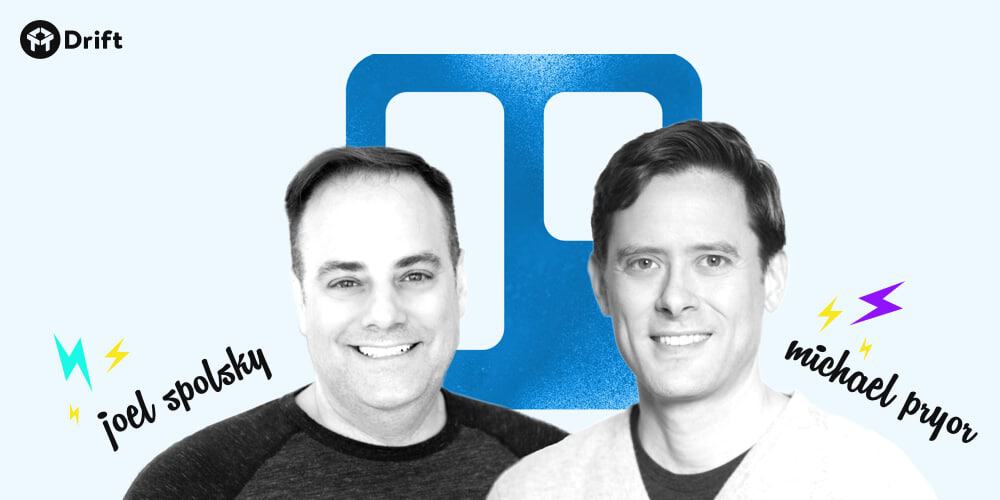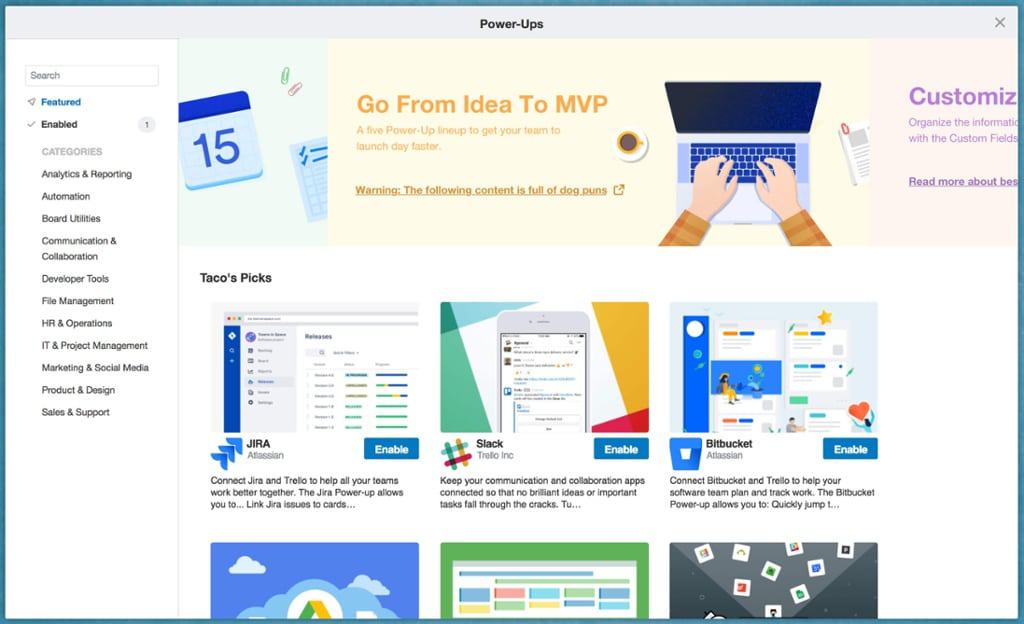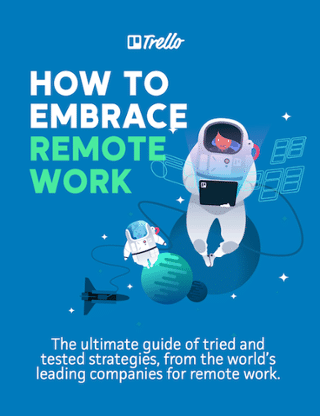
It all started with a sticky note.
And a long to-do list. And two developers. And a dream to make people’s lives more organized and productive, wherever they worked and lived around the world.
The idea to create Trello was formed between the minds of co-founders, Joel Spolsky and Michael Pryor. Their goal was to take the paradigm of a sticky note on a wall and turn this concept into a collaborative, real-time tool. Their goal was to provide people with a clear, fluid, and adaptable understanding of their projects, without getting bogged down by process and structure. And their biggest goal was to someday have 100 million people using Trello.
Within five short years, Trello has achieved the first two goals and is well on its way to 100 million users. But along this journey, they achieved so much more. They rapidly grew from a scrappy startup into a powerhouse brand, built a remote team with employees around the world, onboarded more than 25 millions of users, relied on organic marketing, and was acquired by one of the largest tech companies in the world.
Like every startup, it was a windy journey. But Trello stayed true to their brand and product along the way and implemented a few strategies that contributed to their success. In this article, we’ll explore these tactics and will share several ways your own organization can execute similar strategies and success.
How Trello Climbed To The Top Of The Tech World
The story of Trello is similar to many startups — two developers put their brains and coding expertise together to build a product that challenged the traditional way people work.
Joel Spolsky and Michael Pryor met at a software startup in New York City back in the late 90s. Instead of cruising in the corporate world, they decided to carve their own path and created a company. In 2011, under Fog Creek Software, they created the first prototype of the product, now known as Trello, and called it Trellis. In an interview, Michael Pryor recalls the process of deciding on a better name for the product and eventual company:
“So I went back to my desk and one of the early employees who was working at Trello then and I just sat there and we were in this instant domain search website where you type things and it tells you if it’s available… I did this for 30 minutes and sitting with my head in my hands and I’m like ok that’s it. I guess – I typed trellis one more time and an ad pops up for trello.com. So I ran through the office and I was like, what do you think about Trello?”
The team liked it. With a strong product and name in hand, the team launched at TechCrunch Disrupt in September 2011 and the app took off from there. By July 2014, Trello spun off from Fog Creek, and the app had over 4.75 million users.
Within the next three years, Trello grew exponentially. In 2017, the company was acquired by Atlassian (famous for creating Jira and Bitbucket) and hit 25 million signups. In other words, Trello increased its user base by 426% in 3 years.
So how did Trello achieve this wild growth? There are several ways, but let’s hone in on a few that we consider the most impactful:
- Offering a product that is free, easy-to-use, and customizable.
- Nurturing customer champions and rallying around a lovable brand and mascot (the mascot is a husky named Taco — how could you not love him?)
- Building strong partnerships with other companies.
Freemium, Easy-To-Use, And Customizable Product
The main goal of creating Trello was to build a visually collaborative tool.
Trello’s layout focuses on the team’s view. It’s not just your view or your co-workers view of a project. Instead, it’s a collective view and understanding of any project. Basically, anyone can hop into a Trello board and understand the status of a project or task without having to ping someone on Slack or send an email for an update ?
The tool also had to be easy-to-use and customizable since Trello wants a range of people to use it — at work and even at home. So the team built a horizontal app, which was different than anything else on the market.
When creating a Trello board, it’s like a blank page. The user can build and customize their board to their preferences and processes. It’s not constrained by a predetermined structure. It’s truly customizable.

People obviously liked this approach to project and task management because within the first year, Trello had 500,000 users without any paid marketing or paid subscriptions.
Just like other prized tech companies, such as Slack and MailChimp, Trello offers a freemium subscription. This means their core product is free, forever. Anyone, regardless of location and industry, can use Trello to power their days.
But of course, Trello needed to monetize so they offered three tiers of subscriptions – Trello Gold, Business Class, and Enterprise:
- Trello Gold charges one user $5 per month for one user and they get access to 3 additional Power-Ups and custom board backgrounds.
- Business Class charges $9.99 per month per user and comes with every feature of the free version, along with unlimited Power-Ups.
- Enterprise starts at $20.83 per user per month and comes with Business Class features, additional security, personalized onboarding and support, and more.
It’s important for Trello to maintain a freemium plan for all users. Payment can be a significant barrier to entry and word-of-mouth marketing is crucial to their growth and product awareness, and especially was in their early years.
The theory is this: users will learn about Trello, will try it, and will eventually upgrade if needed as they use and grow with the tool. However, without having to focus on monetization from day one, Trello was able to remain authentic to its brand and goals which led to the creation of an adored brand and die-hard customer champions.
Nurture Customer Champions And Rally Around A Lovable Brand And Mascot
In the beginning, Trello didn’t rely on heavy paid advertising and instead adopted a product-driven approach. The goal was to get as many people as possible to sign up to use Trello. When they first launched at TechCrunch Disrupt, Joel Spolsky said that they hoped to one day have 100 million users.
But instead of dumping budget into paid advertising campaigns and direct sales to gain these users, the Trello team focused on organically attracting users through word-of-mouth and referral strategies.
For example, it’s common for people to hear about Trello because a friend or coworker uses the app. Then the love for the app catches on like wildfire and soon enough, entire departments from engineering to sales and even human resources are using it.
Trello uses a smart referral strategy to incentivize users to refer the app to their networks. It’s called Trello Gold. Trello Gold gives users a taste of the business class features, such as access to three Power-Ups and customized board backgrounds, for one month. Here’s how it works:
1️⃣ A user is on the free plan
2️⃣ She invites a colleague, who has never used Trello, to join her board
3️⃣ Trello Gold is gifted to her for one month in thanks of referring a new user to the app
This is genius strategy since it rewards their superfans for organically inviting more users and gives them a chance to uncover the benefits of a paid subscription, without having to make a commitment right away.
In addition to providing a great experience with their product, the Trello team is excellent at building relationships with their users and champions. They do send swag to their fans (think: Taco stickers), but the real impact is through the connections they build online with their community.
They are constantly chatting with users on social media. The company even has a private Slack channel for its most dedicated fans where they can chat directly with each other and Trello team members about announcements, best practices, product feedback, and general topics related to work, productivity, and more. With an active online presence, Trello champions and users know the team is only a tweet or Slack ping away to chat or answer questions.
Trello is known for its incredible app, but the company is also famous for its mascot, Taco. Taco is co-founder Joel Spolsky’s Siberian husky. They turned him into an adorable cartoon and proudly incorporate him in all aspects of Trello’s branding and marketing. Even their marketing emails are sent as “Taco from Trello.”

This is Taco, the cartoon mascot.

This is real-life Taco.
But why is their company mascot so important? Because it brings a fun, approachable vibe to the Trello brand and allows users to immediately connect over their shared love for the pooch.
For example, real-life Taco passed away (RIP, Taco ?) in October 2017 and Spolsky shared the sad news on Twitter. His tweets received hundreds of responses from Trello users and Taco lovers with messages of condolences and even photos with Taco.

Overall, Trello’s mascot keeps their brand grounded as fun, professional, and friendly. They clearly list this brand identity in their open-source design system, Nachos:
- Fun, without being childish or naive.
- Professional, but still delightful.
- Friendly, but not patronizing.
Sticking to this brand ethos since day one, then nurturing and developing it over the years has resulted in Trello becoming one of the most loved tech apps around the world.
Build Strong Partnerships
At its core, Trello is a collaborative tool. To make the app even more efficient, Trello offers Power-Ups — advanced features and integrations with other applications that turns a user’s boards into a productivity powerhouse. Trello even allows companies to build their own private, custom Power-Ups to serve their unique needs and processes. Some of the most popular Power-Ups allow users to integrate Slack, Google Drive, Wistia, Zendesk, InVision, and Jira. This is a huge benefit of Trello – having multiple applications working together in one tool.
This Power-Up strategy is not only a benefit to their users, but it also benefits Trello. When they create a new Power-Up, for example with InVision, the two companies promote the partnership on their websites, blogs, and social media channels.

For example, InVision wrote a specific blog post announcing their Power-Up integration with Trello. The news and blog post were then shared across InVision’s social media channels which has nearly 300,000 followers across Twitter, Facebook, and LinkedIn.
This is a marketer’s dream — organic social media promotion and authoritative backlinks ?
Trello’s partnerships expand outside of their core product through their content marketing. Nearly 1 million people read the Trello blog every month. Their topics range from productivity hacks and collaboration tricks to case studies on how to use Trello.
One of their marketing goals in 2018 was to position the company as a leader in the remote work world. Trello refers to themselves as a “remote-first” company and has 65% of their team working remotely from around the world.
In order to gain thought leadership with this work style, the Trello content marketing team and their collaborators published dozens of blog articles about remote work topics, strategies, and workflows. The team then tied it all together and created the free How To Embrace Remote Work Guide.

But instead of talking solely about their own best practices and strategies in the guide, they partnered with 10 other companies who also support remote work, such as Evernote, Buffer, Stack Overflow, UNICEF, and Litmus, to share these companies’ strategies and processes.
The guide is a beautiful piece of content that allowed Trello to position itself as a thought leader and to support its partners who are on the same mission to promote remote work as the future of global teams. Each company that was included in the guide wrote blog posts about remote work and then linked to the Trello guide to remote work within the blog post. The content was then amplified on social media and in emails. More authoritative backlinks and more free promotion — a win-win for every company involved.
In addition, Trello didn’t even require readers to fill out a lengthy form to access the guide (kudos, Trello ?). Readers simply clicked the “Download Guide (PDF)” button on the blog post or landing page and the guide immediately opened in a new tab.
And last but not least, Trello made the ultimate partnership in early 2017 by joining forces with tech giant, Atlassian. The company was acquired by Atlassian for a whopping $425 million. But instead of becoming fully integrated with Atlassian, the companies decided to continue to operate Trello as a standalone service. Michael Pryor stated in this blog post why the Trello and Atlassian partnership is a good fit:
“We’re excited about partnering with Atlassian because we both share a philosophy of empowering teams everywhere to work in their own style. We envision a world where hundreds of millions of people collaborate in teams however they like, with their imaginations being the only constraint for what they can accomplish.”
Atlassian expects Trello to add $20 million USD in revenue to its 2018 financial year results. And since going public in 2015, Atlassian hit a market cap of $10 billion for the first time in October 2017.
Being a part of a global tech company, Trello now has the opportunity to continuously expand into new locations and industries. They can leverage investments in R&D in order to enhance the product with new and improved features. And Trello can now focus on paid advertising channels and larger marketing campaigns to continue connecting with current and new users (i.e. the company made it on the big screen in Times Square).
Take a Page From The Trello Playbook
So how can you apply these lessons to your own company and strategies? Here’s some advice:
- ? Create a product that improves the lives of your users.
Trello is free, easy-to-use, and customizable, but its most important aspect is that it actually improves the lives of its users. It boost productivity, reduces the need for status updates, and allows people to work asynchronously from anywhere in the world. When building and marketing your product or services, ask yourself: how is this going to improve the lives of our customers? What are the benefits for them? What pain points can we remove from their day-to-day tasks?
- ?Nurture customer champions.
Customer champions become your referral army. By continuously providing a great customer experience, users will want their friends, coworkers, and even family to jump onboard. Identify your champions and treat them like the superstars they are. After all, they are helping you save on advertising spend.
- ? Build strong partnerships with companies in your industry.
Reaching your ideal customers is easier when you have a little help from your friends. Identify players in your field who you can partner with to collaborate on promotions and content creation. Of course, there has to be a benefit for them. Bottom line: this collective amplification will do wonders for your reach, awareness, and lead generation strategies.
- ✍️ Create content that is valuable and delightful.
Trello does an excellent job of honing in on specific topics that are relevant to their audience and diving deep into them through blog posts and guides. Follow suit by building a content strategy around your customer’s interests, instead of always focusing on your product and its benefits. Position yourself as a thought leader and the go-to-source for topics in your industry that are relevant to your customers. And consider ungating your content. If you’re curious who is on your site and what they’re reading, you can use chatbots to start a conversation.
- ⭐️ Stay true to your brand.
Through the growing pains of a startup and an acquisition, Trello has always stayed true to their brand and ethos. If anything, they’ve improved it over time. Establishing a company brand, values, and even goals allows your company to connect with your customers on a deeper level. Putting in the work to develop and nurture your brand is crucial to growth.

☝️CLICK HERE TO TWEET THIS ADVICE ☝️
Trello has an exciting future ahead and the company is projected to grow even more, thanks to the support of a global team, dedicated users, and a profitable parent company. We’re looking forward to following the journey as it races on a fast track towards 100 million users!
While you’re here, check out some of our earlier stories about other companies that we love:



